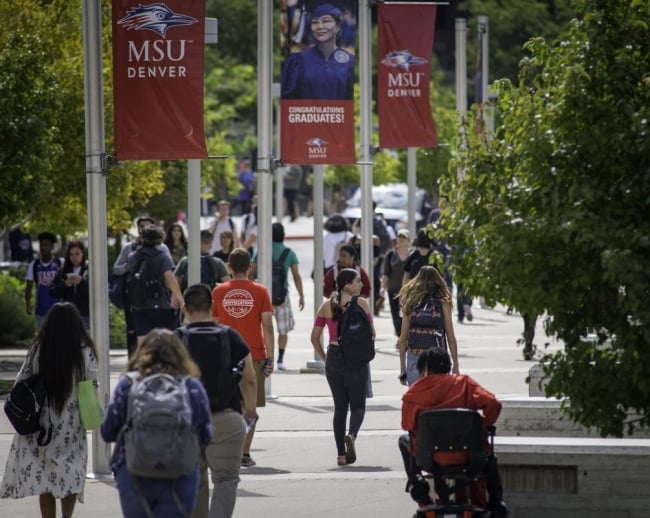You have /5 articles left.
Sign up for a free account or log in.

Courtesy of Metropolitan State University of Denver
Janine Davidson, the president of Metropolitan State University of Denver, is hoping a change to make Colorado one of a few states to reward public colleges for admitting and graduating more students of color will slowly end the long-term underfunding of institutions like hers, where nearly half of students are people of color.
“There is a racist, classist element here. Thirty, 40, 50 years ago, it was considered perfectly OK to underfund students of color or low-income students,” she said. “We’ve been digging out of that hole for decades.”
But even before the killing of George Floyd brought calls for greater racial equity to the nation’s streets, Colorado lawmakers, after watching the state’s colleges make little progress in serving more minority and lower-income students, had decided to change how the state divvies up money it spends on higher education.
Starting in the budget cycle that begins this time next year, the state will move away from increasing annual funding for each of its public colleges and universities by roughly the same percentage. Instead, it will give colleges bonus points if they improve more than others in certain measures, including admitting more minority and low-income students.
Under its new funding formula, Colorado also will be only one of a handful of states in the nation to reward colleges for attracting and graduating more students whose parents did not go to a four-year institution.
However, for a variety of reasons, including the fact that it doesn’t help much to get a greater share of a shrinking pie, it’s unclear whether the change will mean much more money in the near future for institutions like Metropolitan State, which disproportionately educate more minority, low-income and first-generation students.
“Candidly, not a lot,” Joe Garcia, chancellor of the Colorado Community College system, and formerly Colorado’s lieutenant governor and director of the state’s department of higher education, said last week when asked how much of an impact the change will make.
And even if more money were to come, Davidson noted, it will not quickly end a disparity in funding decades in the making.
“We’re going to have to inch away at it over time,” she said of the state’s efforts. “It will take years to make up.”
And according to a recent study, there’s some risk it might backfire. The study of other states that have created bonuses for enrolling and retaining underrepresented minorities found some gains among Hispanics and low-income students. But, unexpectedly and inexplicably to researchers, enrollment by Black students declined in those states.
Experts Back Approach
Still, policy experts like Robert Kelchen, a professor of higher education at Seton Hall University, see explicitly rewarding colleges for increasing diversity, as Colorado is doing, as a better approach than what other states have taken.
About 30 states include performance measures to determine funding for public colleges, but half do not include race among the incentives, according to a study in January by Kelchen’s nonprofit clearinghouse for policy analysis and research, InformED States.
That report cited research by Denisa Gándara, an assistant professor in Southern Methodist University’s department of education policy and leadership, and Amanda Rutherford, an Indiana University assistant professor in public and environmental affairs. Staes that based funding on measures like how often students graduate, but that did not have incentives to increase diversity,, dampened the enrollment of Black, Latino and first-generation students, the study found.
If institutions only are rewarded for measures like graduation rates, she wrote, they might be less likely to accept students they think are less likely to graduate.
On the other hand, Gándara found states that did include bonuses for accepting more underrepresented minority-group students, as well as low-income students, saw an increase in the enrollment of Latino and poorer students.
That was a focus for Colorado’s Democratic governor, Jared Polis, in revamping Colorado’s system. “The governor was really insistent it included factors for equity,” said Angie Paccione, executive director of the Colorado Department of Higher Education.
However, Gándara also found the improvements took a few years to show up, possibly because college administrators didn’t adapt right away.
What continues to perplex Gándara, she said, is that Black enrollment went down in the states that encouraged the admission of more students of color and low-income students.
That could be because institutions responded to the diversity incentives and admitted more students from minority groups -- except Black students -- she wrote in an email.
Gándara doesn't know what that would be. She speculated it could be because Black people have the lowest median household income in the U.S.
“Higher-income students have advantages that increase their likelihood of completing their degree (e.g., less need to work more hours while enrolled in college and lower likelihood of food and housing insecurity, which can hinder college completion),” she said. “So if a university gets bonus funding for admitting any minoritized students, they may be more likely to select those with higher incomes, which they may view as more likely to complete their degrees.”
It could also be because of “perceptions of Black students' ability to succeed, which can be shaped by unconscious racial bias,” she said.
Garcia also did not know why, but doubted that colleges shy away from African Americans out of a bias that they would be less likely to graduate.
“What we’re driven by right now is tuition. We’re really after the bodies. We need bodies in the seats,” he said. “Whether it’s someone who would do well or not well, we’ll take the chance.”
A Colorado higher education department spokeswoman said policy makers are aware of the research and tried to account for it in the formula. But she didn’t expand on how.
Whether other states will follow in giving colleges financial incentives to increase its diversity is unclear. More likely is that states will give bonuses for enrolling and retaining more low-income students and first-generation students, Kelchen said.
“Some state legislatures (especially in conservative states) are hesitant to tie funding to race,” he said in an email. Indeed, Gándara noted that Colorado lawmakers, in examining the state’s higher education funding formula in 2014, added incentives to enroll low-income students but opted then not to create an incentive based on race. “They wanted to avoid what one legislator called an ‘affirmative action debate,’” she said.
But Gándara said other states might be beginning to see the need.
“There does seem to be a greater recognition that in order to reduce racial inequities in educational attainment, we need to address race explicitly,” Gándara said. “For a long time, many policy makers, campus officials and researchers have assumed that by addressing income, racial disparities will disappear. But at this moment, more people are beginning to reckon with the fact that race matters and racism matters.”
Garcia, who was involved in the 2014 change, said additional data on the failure to make much progress for minorities helped convince lawmakers to include race this time.
Impact on Colleges Unclear
In making the change, Colorado is moving away from a system in which all colleges would largely get the same percentage increase in their budgets, locking in one in which historically underfunded colleges serving minorities and the needy would continue to be underfunded.
“The same percentage of a smaller number is still a small number,” Davidson said.
But how much the new formula will change what individual universities will get is difficult to predict, said college presidents and the state's higher education department.
Universities will get bonus points if they improve more than other institutions in a number of areas, including enrollment by Colorado residents, as well as first-generation students and underrepresented minorities. Also counted are improvements in the percentage of Colorado students who are eligible for Pell Grants. The formula also factors in the percentage of first-time, full-time students who earn their bachelor's degree within four years, and within six years, as well as their associate's degree within two and four years.
What’s tempering expectations, though, is that even if colleges get a bigger share of the state’s higher education spending, Colorado likely won’t have much more to spend for least a couple of years. The state is facing a $6.8 billion budget deficit this year due to the pandemic.
“We got clobbered this year,” Garcia said. And the following year “doesn’t look that much better.”
And even before the pandemic, Colorado hasn’t invested as much as others in its public colleges, ranking 48th nationally.
At the same time, while the formula might encourage colleges to accept more minority and low-income students, those groups are also seen as the most likely to have to put off going to college or to drop out during hard economic times.
Some, including Cheryl Lovell, president of Adams State University, which enrolls the lowest percentage of white students in the state, are optimistic more money might be coming.
“We’re really excited about the formula. It plays to our sweet spot,” she said.
But asked if the new formula would push them harder to recruit and retain the underrepresented groups, the state’s university systems said they already are trying.
“If I were in this spot 10 years, ago, this formula would have been a wake-up call,” said Tony White, chancellor of the Colorado State University system.
But he said the system's campuses have made strides in recruiting and retaining underrepresented students.
The University of Colorado at Boulder also said it has been working to attract and recruit underrepresented students. The campus said that 28 percent of last year’s incoming class were first-generation students, which was a record. And the 2,007 students of color in last year's incoming freshman class more than doubled the 901 a decade earlier.
“We are in alignment with and support the state’s efforts to put greater focus on underrepresented students and their academic success. This is a goal we’ve had as a campus for years, and we are committed to making progress,” the university said in a statement.
“While we have made progress, we know we can and must do better,” it said, noting that Phil DiStefano, Boulder's chancellor, announced a series of steps last month to make the campus more diverse and equitable, including stepping up recruitment at high schools that serve communities of color.
To Garcia, though, the new formula’s main impact could come from the fact that the data will be made public. It will be easy to see which colleges are not doing well.
Some presidents, however, are concerned about how the formula will work in practice. Colleges might gain bonus points by increasing enrollment of low-income or minority students, but that could be offset by others getting bonus points for doing better at graduating students in four years, a standard Davidson thinks is unfair to institutions like hers.
“That represents a lack of understanding,” she said of using four years as a standard. “We can have a Jenny Dooley graduate straight from high school to college and graduate in four years. But you know who does that? Rich kids,” she said.
Students at Metropolitan State are more likely to take longer to graduate because they have to work while attending college part-time, or they stop to raise their children and come back to college.
“Our average college student is not Jenny,” she said.
“The proof is in the pudding,” said Steven Schwartz, chief operating officer and vice president for finance and administration at Fort Lewis College, which was founded primarily to give Native American students a free college education, and where slightly half of the students are from minority groups.
He praised the goal of the formula change but worried what would happen if the economic fallout from the pandemic leads to fewer Black students enrolling at his college than others.
“Playing the speculation game is the stuff that keeps me up at night,” he said. “What allows me to sleep at night are the policy goals.”








